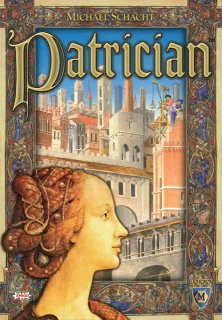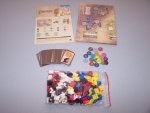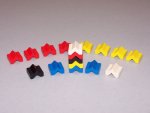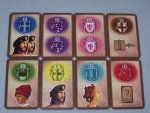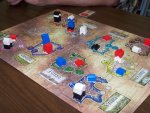
|
Patrician A game by Michael Schacht Published by Amigo Spiele and distributed in the US by Mayfair Games, Inc. Players: 2-5 Time: 45 minutes Reviewed by Susan Rozmiarek |
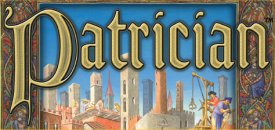
|
Patrician is a game about building tower-like homes in the cities of Italy during the Middle Ages. Players are master builders trying to earn the most prestige by building these towers for Patrician families.
Components:
- Game board - this depicts the different cities of Italy and is double-sided. One side adds an additional city for the five-player game.
- 149 tower pieces in five colors. These are nice and chunky and they nestle together for stability when stacked. There are unequal amounts of the different player colors. Certain colors must be used when playing with different numbers of players. This is a minor annoyance to me as I prefer to play with certain colors.
- 20 Prestige tokens, 2 of each color.
- 55 building cards in 10 colors
- Rulebook - four pages, nicely illustrated in color.
Game play:
Players are trying to collect the most prestige points by having the majority of floors in towers and by collecting sets of Patricians.
The game board depicts nine cities (ten on the five-player side).
There are two building locations at each city.
Two tokens with numbers are placed in each matching city at the start of the game.
A building card is randomly drawn and placed next to each city as well.
Players start with a hand of three cards. On their turn, players will play a card, place one or two tower pieces in the matching city, take a special action if one is depicted on the played card, and pick up the card at that city to fill their hand back to three. A new card is drawn to replace the card taken. Each city has a maximum number of tower floors it can hold and when it is full, it is scored. The player with the majority of floors in the tallest tower takes the token with the higher number and the player with the majority in the second tallest takes the token with the smaller number. This city is now closed for the rest of the game. Ties are broken in favor of the player who has the highest floor in the tower. There are just enough cards to fill every city and the game ends when the last city has been filled.
The cards either have two city crests or one crest and either one or two Patricians or a special action. Players place tower pieces equal to the number of crests on the card played. There are two types of special actions. One allows a player to move the top floor of one tower to the other in another city location provided he has at least one floor in that city. This can be a very powerful action played at the right time if it changes the majority or the tiebreaker in either tower. The other action allows a player to refill his hand with any card on the board. This can be useful if a player really wants a particular card but doesn't have a card to play in that city. As players play their cards, they keep them in a pile in front of them. In this way, they collect sets of the four different Patrician families whose portraits are depicted on some cards.
When the last city is closed, players total the prestige tokens they have collected. They then add six points for each matching set of three Patricians they have collected. The player with the highest total wins the game.
Comments:
Where the two games do differ greatly is in the way you refill your hand of cards. In Web of Power, you have a choice of two display cards or drawing blindly from the deck. Your selection is limited by luck-of-the-draw and you are trying to make the best tactical decision when choosing a card. In Patrician however, your decision feels even more limited. When you choose a location from the three in your hand in which to play a tower piece, you have also just chosen which card you will be getting to refill since you must take the card at that location. (With one exception which is a special action) This drives you to want to go beyond simple tactics and try to plan a bit more ahead along the lines of, "if I play this card, I get that card which I can play over there the next turn which will get me a majority in that tower and a complete set of Patricians". This is a rather enjoyable thought process for me which is completely ruined by the fact that, at least with four or five players, my chain of clever moves will most assuredly be broken by another player by the time my turn comes around again. This makes what could have been a very clever game into a rather shallow one and a bit of a disappointment for me.
Fortunately, the game plays much better with just three players and more planning is possible. With just two players though, the game is somewhat boring as there isn't enough competition at the different locations.
One interesting feature of Patrician is the fact that there are exactly enough cards in the deck to fill each and every city with tower floors. So, as the game goes on you can save cards, especially the double ones, to make plays near the end that give you a majority and/or tiebreaker by playing last in that city. However, you are somewhat hampered in doing so by the hand limit. The last few turns in a game often devolve into a "chicken" to see who can hold out playing last in a city. I'm not sure whether I like this or not. Also, Patrician sets can yield game-swinging points at the end, so they can't be ignored. Focusing on collecting sets (if you are able - see my comments above about the number of players) rather than being overly worried about towers seems to be a viable strategy.
One of the major strengths of Patrician is that it is a simple game to teach to new players. Like several of Schacht's other games, it is a streamlined, elegant design that is centered on a few core mechanisms. It also plays very quickly. Our games clocked in at about 20-30 minutes, much shorter than the 50 minutes stated on the box. The theme is boring and pasted-on, but the thematic art does give the game a very attractive, classy look. I do have to add that I am getting tired of games that involve building and area majority control. The twists in Patrician are not quite enough to make it feel totally new to me. Still, I enjoyed my three-player games. While Patrician is not a spectacular game- I wish it had a little more depth and it played better with more players - it is a rather nice filler for three.
| Other Web information: |
This page viewed
E-mail Ed Rozmiarek with questions or problems concerning this page.
Copyright © 2007, Ed & Susan Rozmiarek. No portion of this website may be reproduced or copied without the consent of Ed or Susan Rozmiarek.
